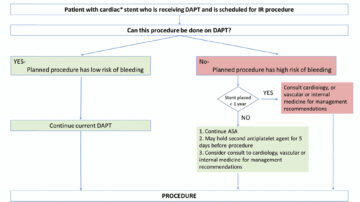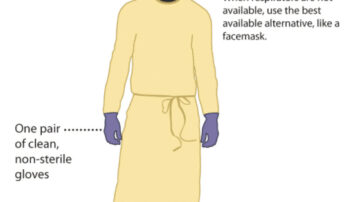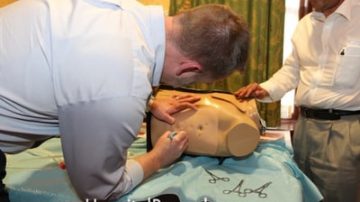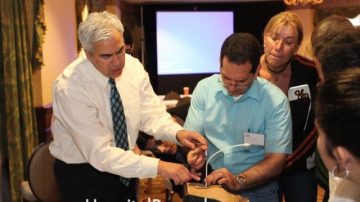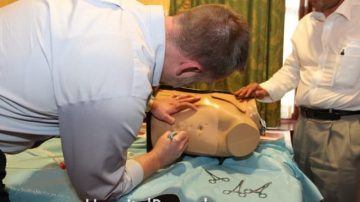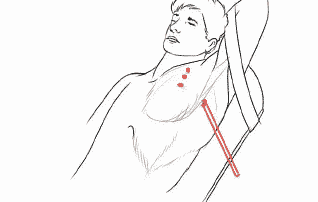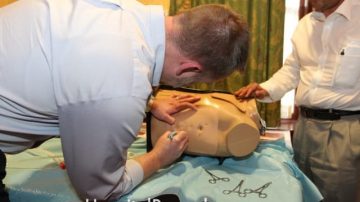This blog summarizes the 2019 Society of Interventional Radiology (SIR) for Periprocedural Management of Image-guided Procedures with regards to thrombocytopenia, coagulopathies, antiplatelets and anticoagulation. The SIR guidelines are summarized as follows: Anticoagulation with heparin, LMWH, fondaparinux, argatroban, warfarin, DOAC, clopidogrel, ticagrelor…
Read MoreMore Articles – Arterial line, Chest Tube, Featured, Gastrointestinal diseases, Hospital Procedures, Paracentesis, Thoracentesis
This blog aims to summarize the data available on how to safely perform invasive hospital procedures in patients with cirrhosis. Unfortunately, no prospective randomized controlled trials have been conducted to inform the practice of procedural medicine in cirrhotic patients. Therefore,…
Read MoreA number of additional factors must be considered with airway management in COVID-positive patients. Hospital Procedures Consultants (HPC) can provide simulation-based training to prepare providers for airway management in COVID-positive patients. The first essential consideration is to place the patient into a…
Read MoreMore Articles – Cardiovascular diseases, Central line, Chest Tube, Endotracheal Intubation, Featured, Hematology, medical procedures, Thoracentesis
Traditionally, it was felt that the INR had to be less than 1.5 and platelets had to be at least 50,000/µL to perform most bedside procedures. With more clinical evidence, we now know that low-risk bedside procedures can be performed…
Read MoreChest tube placement, or tube thoracostomy, can be an anxiety-provoking procedure for both the patient AND the operator. It can also be a very gratifying procedure for the operator when performed successfully and without patient discomfort. Here are a few…
Read MoreMore Articles – Cardiovascular diseases, Central line, Chest Tube, Featured, Infections, King Tube, medical procedures, Respiratory diseases, Thoracentesis
More Tags – chest tube, empyema, featured, HPC updates, parapneumonic effusion, pleural effusion, thoracentesis, tube thoracostomy
Complicated parapneumonic effusions frequently represent pleural space infections. Approximately 1 in 7 cases of pneumonia have an associated parapneumonic effusion (PPE) on chest x-ray. Most of these effusions are small and usually resolve spontaneously with prompt antibiotic administration. However, moderate-to-large…
Read MoreMore Articles – Central line, Chest Tube, Emergency Procedures, Featured, Glidescope Intubation, Lumbar Puncture, Paracentesis, Thoracentesis
Medical procedural education in the era of COVID19 is still best conducted via HANDS-ON simulation-based procedural training. Procedural skills can NOT be attained via remote education, but in-person training must be conducted safely. There are many topics and skills that can be successfully be taught online,…
Read MoreWhere to place a central venous catheter is a decision driven mainly by individual preference. The limited evidence available has not established any site as superior; the subclavian position has been reported as being less infection-prone, but more likely to cause…
Read MoreTraditional teaching is that chest tubes placed to evacuate a pneumothorax should be directed anterior and superior and to evacuate fluid should be directed posterior and inferior. A recent study examined the effect of specific chest tube position on chest…
Read MoreMore Articles – Cardiovascular diseases, Chest Tube, Emergency Procedures, Featured, medical procedures
The optimal insertion site for tube thoracostomy is at the mid-axillary line in the triangle of safety. This avoids any major nerves or arteries aside from the intercostal vessels. Ultrasound-guided localization of this site performed better than palpation. In semi-elective…
Read MorePleural fluid pH is an important measure for determining the clinical management of pleural diseases. For example, a pleural fluid pH <7.2 in patients with suspected pleural infection should mandate the placement of a chest tube. However, pleural fluid pH…
Read MoreA retrospective study compared the performance of Fluid and Catheter Treatment Trial (FACTT) Lite, FACTT Conservative, and FACTT Liberal. The prior FACTT demonstrated that conservative fluids is superior to liberal fluids for ARDS. A simplified conservative fluid protocol (FACTT Lite)…
Read MoreA collection of recent studies has helped determine the best protocol for removing chest tubes. For instance, a trial of water seal for at least six hours is recommended before discontinuation. The water seal reduces the need for another chest…
Read MoreMore Articles – Cardiovascular diseases, Chest Tube, medical procedures, Needle Decompression, Respiratory diseases, Traumatology
A recent meta-analysis of 13 studies that were investigating needle decompression compared data of sample size, mean chest wall thickness, and decompression success rates. The meta-analysis concluded that the needle decompression catheter should be at least 6.5 cm in length…
Read MoreA prospective cohort single center study was conducted to analyze the risk associated with patients undergoing thoracentesis or small-bore chest tube placement while taking clopidogrel. Twenty-five patients taking clopidogrel gave consent to remain on the antiplatelet medication while undergoing thoracentesis…
Read MoreCategories
- ACLS (1)
- Arterial line (33)
- Cardiovascular diseases (77)
- Central line (55)
- Chest Tube (39)
- Dermatology (4)
- Emergency Procedures (139)
- Endocrinology (6)
- Endotracheal Intubation (36)
- Events (24)
- FAST Exam (12)
- Featured (113)
- Featured Procedure (42)
- Gastrointestinal diseases (32)
- Ginecology (3)
- Glidescope Intubation (21)
- Hematology (33)
- Hospital Procedures (85)
- Infections (32)
- Intraosseous line (8)
- King Tube (27)
- Laryngeal Mask Airway (18)
- Lumbar Puncture (36)
- Mechanical Ventilation (34)
- Medical General (95)
- medical procedures (258)
- Needle Decompression (6)
- Nephrology (11)
- Neurological diseases (12)
- Oncology (4)
- Paracentesis (32)
- Pericardiocentesis (3)
- Procedural Sedation (19)
- Respiratory diseases (85)
- RUSH Exam (8)
- Thoracentesis (37)
- Traumatology (24)
- Travel (27)
- Ultrasound-Guided Peripheral IV (13)

